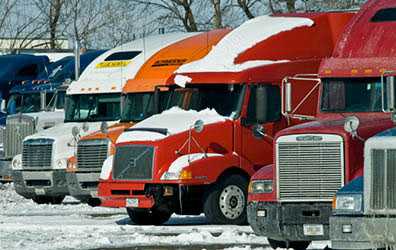Improved Safety for Truck Drivers: Designing Safer Cabs Based on Driver Body Dimensions
August 2011
DHHS (NIOSH) Publication Number 2011-188

The design and dimensions of truck cabs can have an impact on the safety and comfort of the driver. Photo by Contemplative Imaging, downloaded from Flickr.
A Story of Impact:
Truck driving can be a hazardous occupation. According to the Bureau of Labor Statistics, in 2009 truck drivers experienced 16.8% of all transportation-related fatalities and 2.04% of the nonfatal injuries requiring days away from work, even though they only made up 1.0% of the U.S. workforce.1
Truck drivers spend long hours behind the wheel, working an average of 41.5 hours per week.2 Therefore, a well-designed truck cab can make a significant difference in the working conditions for a truck driver. Truck cab design impacts comfort, but more importantly impacts the safety of truck drivers and other road users. For example, if the design of the truck cab is poorly fitted to the size and dimensions of the driver, the road may be less visible, driving controls may be more difficult to reach, and seatbelts may be less comfortable and less likely to be used—all of which increase the risk of injury to the driver and other road users.
Truck manufacturers consider the body dimensions of truck drivers as they design truck cabs. However, until recently the most current body measurement data for truck drivers dated from the early 1980s. The composition of the trucker workforce has changed dramatically in the past 30 years, with an increase in the diversity of ethnic groups and the percentage of women working in this profession.3 As the truck manufacturing industry moves forward to design the next generation of truck cabs, there is a pressing need for up-to-date information on the body dimensions of U.S. truck drivers.
Relevant Information
- Approximately 1.5 million U.S. workers were employed as drivers of heavy trucks and tractor-trailers in 2009.4
- 36% of collisions between trucks occur in blind spots around the vehicle.5
- The rate of seatbelt use is relatively low among truck drivers, even though seatbelt use has been proven to save lives.6
- 62% of truckers who do not wear a seatbelt complained that the seatbelt was uncomfortable.6
Impact
In 2006, researchers at the National Institute for Occupational Safety and Health (NIOSH) began a 4-year study to measure the body dimensions of the current truck driver workforce. With the active support of multiple trucking industry partners, researchers were able to recruit a diverse group of nearly 2,000 truck drivers nationwide and record their weight, height, and 33 other body measurements. These measurements showed significant differences between the current truck driver workforce and truck drivers 30 years ago.
This information has been shared with the trucking industry, and is being widely used to update and improve truck cab design. Four truck manufacturers and 3 parts suppliers have utilized the data to create truck cabs with increased visibility, better fitting seat belts, and easier entry. The design software RAMSIS is being updated with the new measurement information for use in truck cab design across the industry. In addition, the Society of Automotive Engineers has affirmed its plan to update multiple truck cab standards based on the new data. Each of these changes provides an important contribution to the safety and health of the nation's truck driver workforce.
View/Download Entire Document: Improved Safety for Truck Drivers: Designing Safer Cabs Based on Driver Body Dimensions [PDF - 840 KB]




For more information on truck driver measurements
Authors of Improved Truck Cab Design Through Applied Anthropometry—Jinhua Guan, Hongwei Hsiao, Richard Whisler, Bradley Newbraugh, Douglas Cantis, Joyce Zwiener, and Richard Current; Division of Safety Research; NIOSH—received the 2011 Bullard-Sherwood r2p Award in the Knowledge category.
References
1 BLS [2009]. Industry Illness and Injury Data, 2009. Washington, DC: U.S. Department of Labor, Bureau of Labor Statistics, Safety and Health Statistics Program [http://www.bls.gov/iif/oshsum.htm#09Summary%20Tables].
2 BLS [2011]. Career Guide to Industries, 2010-11 Edition: Truck Transportation and Warehousing. Washington, DC: U.S. Department of Labor, Bureau of Labor Statistics, Safety and Health Statistics Program [http://www.bls.gov/oco/cg/cgs021.htm].
3 BLS [2009]. Labor Force Characteristics by Race and Ethnicity, 2009. Washington, DC: U.S. Department of Labor, Bureau of Labor Statistics, Safety and Health Statistics Program [http://www.bls.gov/cps/].
4 BLS [2010]. Occupational Employment and Wages, 2010. Washington, DC: U.S. Department of Labor, Bureau of Labor Statistics, Safety and Health Statistics Program [http://www.bls.gov/oes/current/oes533032.htm#(1)].
5 Federal Highway Administration [1999]. Share the Road Campaign Research Study, Final Report (FHWA-MC-99-053). U.S. Department of Transportation, Federal Highway Administration.
6 Bergoffen G, Knipling R, Tidwell S, Short J, Krueger G, Inderbitzen R, et al [2005]. Commercial motor vehicle driver safety belt usage. Washington, DC: Transportation Research Board.
SAFER • HEALTHIER • PEOPLE™
- Page last reviewed: June 6, 2014
- Page last updated: June 6, 2014
- Content source:
- National Institute for Occupational Safety and Health Education and Information Division


 ShareCompartir
ShareCompartir